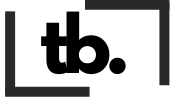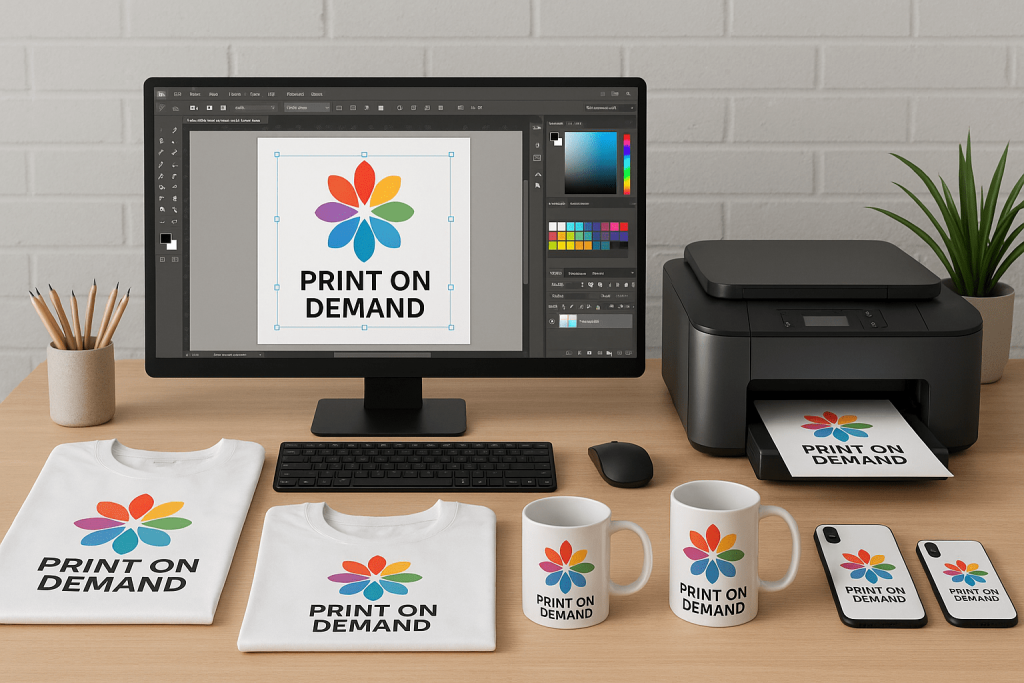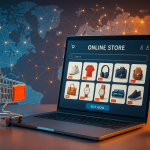Print-on-demand (POD) has emerged as one of the most revolutionary business models in the digital commerce era, transforming how creators, entrepreneurs, and businesses monetize their creativity. Unlike traditional retail models that require substantial upfront investments in inventory, POD allows anyone to launch a profitable venture with minimal financial risk and maximum creative freedom.
The print-on-demand industry represents a paradigm shift in commerce, where products are created only after customers place orders. This innovative approach eliminates the need for inventory management, reduces financial risk, and enables creators to focus on what they do best: designing unique, compelling products that resonate with their target audience.
The Booming POD Market Landscape
The print-on-demand market is experiencing unprecedented growth, with industry analysts projecting remarkable expansion in the coming years. According to recent market research, the global POD market was valued at $10.21 billion in 2024 and is projected to reach an astounding $102.99 billion by 2034, representing a compound annual growth rate (CAGR) of 26%. Some projections are even more optimistic, with estimates suggesting the market could reach $59.4 billion by 2033 at a CAGR of 20.89%.
This explosive growth is driven by several key factors:
- Increasing e-commerce adoption: The shift toward online shopping has accelerated demand for customizable products
- Consumer preference for personalization: Modern consumers increasingly seek unique, personalized items that reflect their individual style
- Technological advancements: Improved printing technologies and AI tools have made high-quality, cost-effective production more accessible
- Low barrier to entry: The minimal startup costs attract entrepreneurs from diverse backgrounds
North America currently dominates the POD market, home to industry leaders like Printful, Printify, and Zazzle. However, the Asia-Pacific region is expected to experience the highest growth rate of 28% during the forecast period, indicating significant global expansion opportunities.
Understanding the Print-on-Demand Business Model
How POD Works
The print-on-demand business model operates on a simple yet effective principle: products are manufactured only after orders are received. Here’s how the process typically unfolds:
- Design Creation: Creators develop unique designs using various tools and software
- Product Upload: Designs are uploaded to POD platforms and applied to chosen products
- Customer Orders: When customers purchase items, orders are automatically forwarded to fulfillment partners
- Production: Products are printed, packaged, and shipped directly to customers
- Profit Collection: Creators receive their profit margin after production and shipping costs
Key Advantages of POD
Low Financial Risk: Unlike traditional retail, POD requires no upfront inventory investment. Creators only pay for production after receiving orders.
Scalability: The model allows for unlimited product variations without additional inventory costs, enabling rapid scaling based on demand.
Global Reach: POD platforms often have worldwide shipping capabilities, allowing creators to reach international markets without complex logistics.
Creative Freedom: Designers can experiment with various products and designs without financial constraints, fostering innovation and creativity.
Automated Fulfillment: Most POD services handle the entire fulfillment process, from printing to shipping, allowing creators to focus on design and marketing.
Top Print-on-Demand Products and Niches
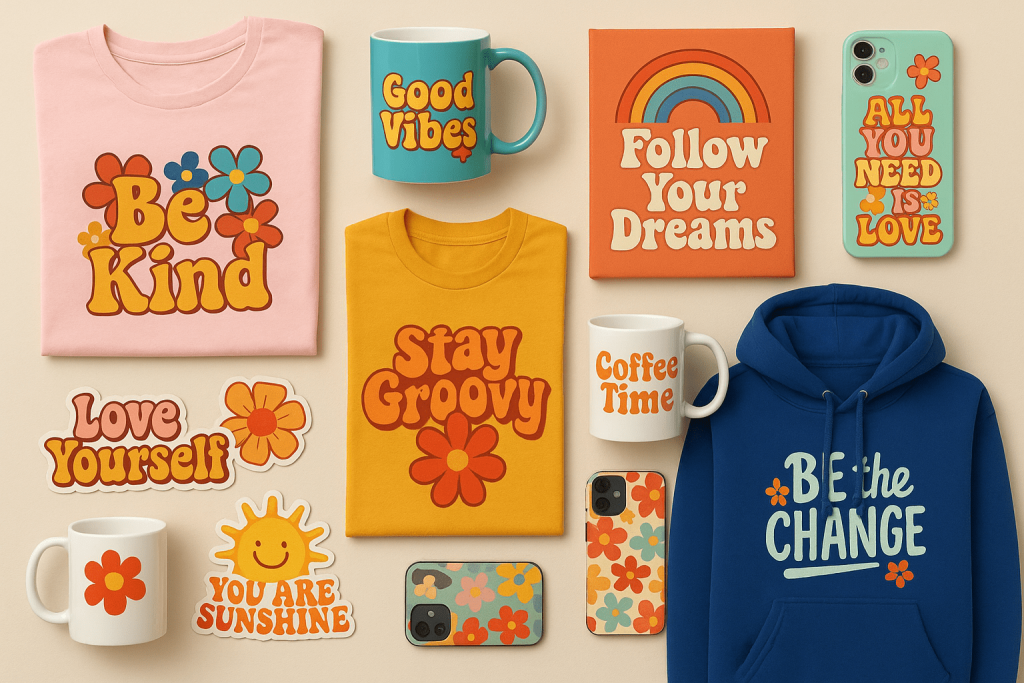
Best-Selling POD Products
Market research reveals that certain products consistently outperform others in the POD space. The most successful categories include:
Apparel:
- T-shirts: The classic POD product with profit margins ranging from 10% to 50%
- Hoodies and sweatshirts: Higher-priced items with better profit potential
- Activewear: Growing segment driven by fitness and wellness trends
- Accessories: Hats, socks, and bags offer diverse monetization opportunities
Home Decor:
- Mugs: Timeless bestsellers with consistent demand
- Wall art: Posters, canvases, and prints for home personalization
- Pillows and cushions: Comfort items with high customization potential
- Candles: Emerging category with premium pricing opportunities
Tech Accessories:
- Phone cases: High-demand products with frequent replacement cycles
- Laptop sleeves: Professional market with good profit margins
- Mousepads: Gaming and office markets provide steady demand
Specialty Items:
- Stickers: Low-cost, high-volume products with loyal customer bases
- Personalized gifts: Custom items for special occasions and holidays
- Pet products: Rapidly growing niche with passionate consumers
Profitable Niches
Successful POD businesses often focus on specific niches rather than broad markets. High-performing niches include:
- Pet lovers: Custom pet portraits and breed-specific designs
- Fitness enthusiasts: Motivational quotes and workout-themed apparel
- Hobby communities: Designs for knitting, gaming, cooking, and other interests
- Professional groups: Items for teachers, nurses, engineers, and other careers
- Seasonal trends: Holiday-themed products and event-specific items
Creative Monetization Strategies for POD Success
Diversified Revenue Streams
Successful POD entrepreneurs implement multiple monetization strategies to maximize earnings:
Direct Sales: Primary revenue through platform sales (Etsy, Amazon, Shopify)
Subscription Models: Offering exclusive designs to subscribers
Licensing: Selling design rights to other businesses
Custom Design Services: Providing bespoke design work for clients
Educational Content: Creating courses and tutorials about POD success
Pricing Strategies
Effective pricing is crucial for POD profitability. Industry data shows that successful POD entrepreneurs typically maintain profit margins between 20% and 50%, depending on various factors:
- Product type: Apparel typically achieves 40% margins, while mugs and candles can reach 45-60%
- Niche specialization: Specialized niches often command premium pricing
- Brand recognition: Established brands can charge higher prices
- Quality positioning: Premium materials and printing justify higher costs
Customer Engagement Tactics
Building lasting customer relationships drives repeat business and word-of-mouth marketing:
- Personalization: Offering custom names, dates, and messages
- Limited editions: Creating scarcity through exclusive designs
- Seasonal campaigns: Aligning products with holidays and events
- Community building: Fostering customer communities around shared interests
AI Tools Revolutionizing POD Design

The AI Revolution in POD
Artificial intelligence is transforming the POD landscape, with the global AI art market growing from $3.2 billion in 2023 to an expected $40 billion by 2030. AI tools are solving critical challenges for POD entrepreneurs:
- Faster design creation: AI can generate professional designs in seconds
- Cost reduction: Eliminating the need for expensive design software or freelancers
- Trend adaptation: AI tools help creators quickly respond to market trends
- Quality improvement: Advanced algorithms ensure high-resolution, print-ready outputs
Top AI Tools for POD
Design Generation:
- Midjourney: Creates highly realistic and artistic visuals
- DALL-E 3: User-friendly interface for diverse design generation
- Leonardo.Ai: Specialized POD tools with commercial rights
- Adobe Firefly: Integrates with professional design workflows
Workflow Optimization:
- Canva: AI-powered design suggestions and templates
- Printify AI: Integrated design tools within the platform
- Printful: Automated mockup generation and order processing
Content Creation:
- Jasper Art: Combines image generation with copywriting tools
- ChatGPT: Assists with product descriptions and marketing copy
Best Practices for AI Design
To maximize AI tool effectiveness while maintaining legal compliance:
- Understand copyright implications: Ensure AI-generated content doesn’t infringe on existing copyrights
- Maintain brand consistency: Use AI as a tool while preserving your unique brand voice
- Quality control: Always review AI-generated content for accuracy and appropriateness
- Combine AI with human creativity: Use AI as inspiration rather than replacement for human insight
Building Your POD Business: Step-by-Step Guide

Phase 1: Foundation Setup
Choose Your Niche: Research profitable niches with passionate audiences. Consider your interests, skills, and market demand.
Select Products: Start with 3-5 products to test market response before expanding.
Platform Selection: Choose between marketplace platforms (Etsy, Amazon) and independent stores (Shopify, WooCommerce).
Phase 2: Design and Production
Create Compelling Designs: Use AI tools, hire freelancers, or develop designs yourself. Focus on quality over quantity.
Optimize for Print: Ensure designs meet platform requirements for resolution, format, and dimensions.
Order Samples: Test product quality before launching to customers.
Phase 3: Launch and Market
SEO Optimization: Implement keyword research and optimize product listings for search visibility.
Social Media Marketing: Build presence on platforms where your target audience is active.
Paid Advertising: Consider Facebook, Google, and Pinterest ads for scalable growth.
Financial Planning
Startup Costs: Initial investment typically ranges from $300 to $1,000 depending on platform choice and marketing budget.
Monthly Expenses: Ongoing costs include platform fees, marketing, and design tools, typically $100-500 monthly.
Revenue Projections: Successful sellers often reach $1,000 in monthly revenue within 4-6 months with consistent effort.
Marketing and SEO Strategies for POD Success
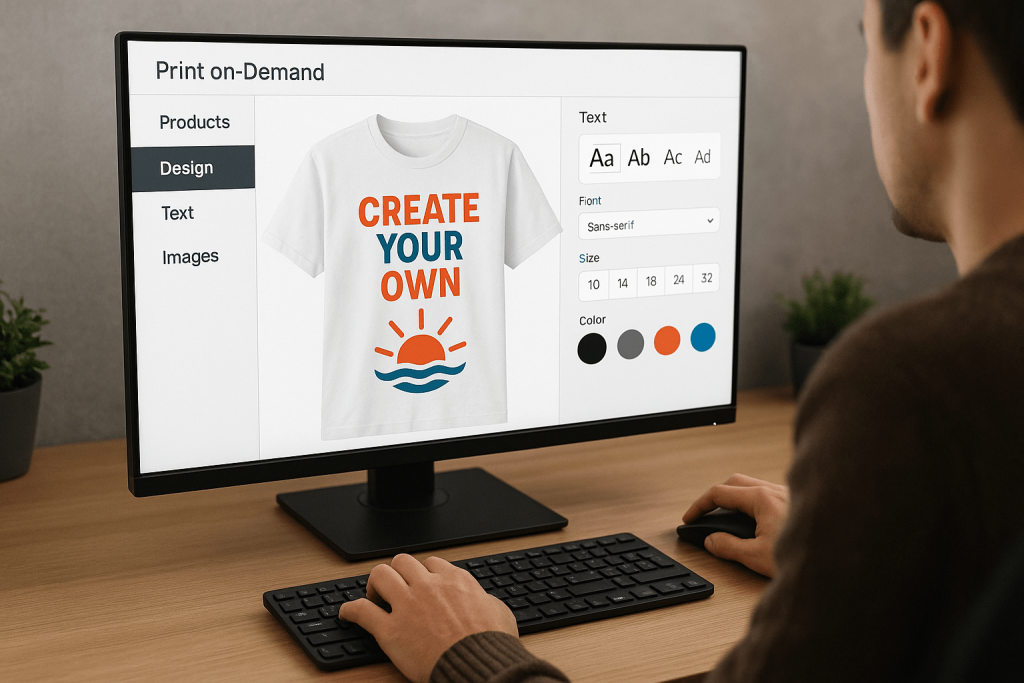
SEO Fundamentals for POD
Search engine optimization is crucial for long-term POD success. Effective SEO strategies include:
Keyword Research: Use tools like Google Keyword Planner, Ahrefs, or SEMrush to identify profitable keywords.
Long-tail Keywords: Target specific phrases like “funny pug t-shirt” rather than broad terms like “t-shirt”.
Product Optimization: Include keywords in titles, descriptions, and tags while maintaining readability.
Content Marketing: Create blog posts, tutorials, and guides to attract organic traffic.
Platform-Specific Strategies
Etsy SEO: Focus on long-tail keywords and seasonal trends. Optimize shop sections and product categories.
Amazon SEO: Prioritize backend keywords and customer reviews. Use Amazon’s A9 algorithm optimization techniques.
Google Shopping: Implement structured data and product feeds for visibility in Google’s product search results.
Social Media Marketing
Pinterest: Visual platform perfect for POD products. Create boards organized by themes and seasons.
Instagram: Showcase products through high-quality images and Stories. Use relevant hashtags and collaborate with micro-influencers.
TikTok: Create engaging content showing products in use. Leverage trending sounds and challenges.
Facebook: Build communities around your niche. Use Facebook Groups and targeted advertising.
Profit Margins and Financial Considerations
Understanding POD Profitability
POD profitability depends on several factors that successful entrepreneurs carefully manage:
Average Profit Margins: Industry data shows profit margins typically range from 15% to 60%, with most successful sellers achieving 25% to 50%.
Product-Specific Margins:
- T-shirts: 15-30% margins
- Hoodies: 25-40% margins
- Mugs: 30-45% margins
- Premium items: 40-60% margins
Cost Structure Analysis
Production Costs: Base cost of manufacturing the product
Shipping Fees: Delivery costs to customers
Platform Fees: Commission charged by selling platforms
Marketing Expenses: Advertising and promotional costs
Design Costs: Investment in creating or purchasing designs
Revenue Optimization
Pricing Strategies: Use competitive analysis to set optimal prices
Upselling: Offer product bundles and premium variants
Seasonal Pricing: Adjust prices based on demand cycles
Geographic Pricing: Consider regional pricing differences
Platform Selection and Integration
Top POD Platforms 2024
Printful: Known for high-quality products and global shipping
Printify: Extensive supplier network with competitive pricing
Gelato: Specializes in stationery and paper products
Gooten: Strong in home decor and custom items
Marketplace Integration
Etsy: Ideal for handmade and vintage-style products
Amazon Merch on Demand: Access to Amazon’s massive customer base
Shopify: Full control over store design and customer experience
eBay: Auction-style selling with global reach
Platform Comparison Factors
Product Catalog: Range and quality of available products
Printing Quality: Output resolution and material options
Shipping Speed: Fulfillment and delivery times
Geographic Coverage: International shipping capabilities
Integration Options: Compatibility with selling platforms
Customer Support: Quality of seller assistance
Future Trends and Opportunities
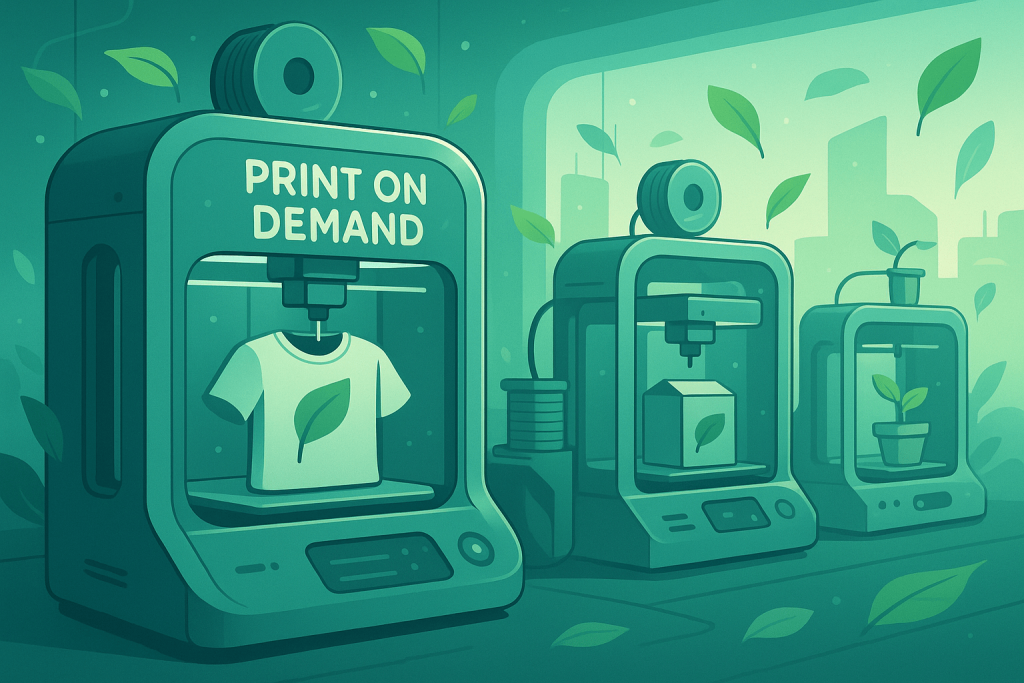
Emerging Technologies
3D Printing: Expanding beyond traditional printing to three-dimensional products
Augmented Reality: Virtual try-on experiences for apparel and accessories
Blockchain: Potential for NFT integration and digital ownership verification
Sustainable Materials: Growing demand for eco-friendly printing options
Market Evolution
Sustainability Focus: Increasing consumer preference for environmentally conscious products
Personalization Advances: AI-driven custom recommendations and designs
Mobile Commerce: Optimizing for mobile shopping experiences
Global Expansion: Emerging markets offering new opportunities
Investment Opportunities
AI Development: Tools for automated design and optimization
Sustainable Printing: Eco-friendly materials and processes
Niche Platforms: Specialized marketplaces for specific industries
Logistics Innovation: Faster, more efficient fulfillment systems
Success Stories and Case Studies
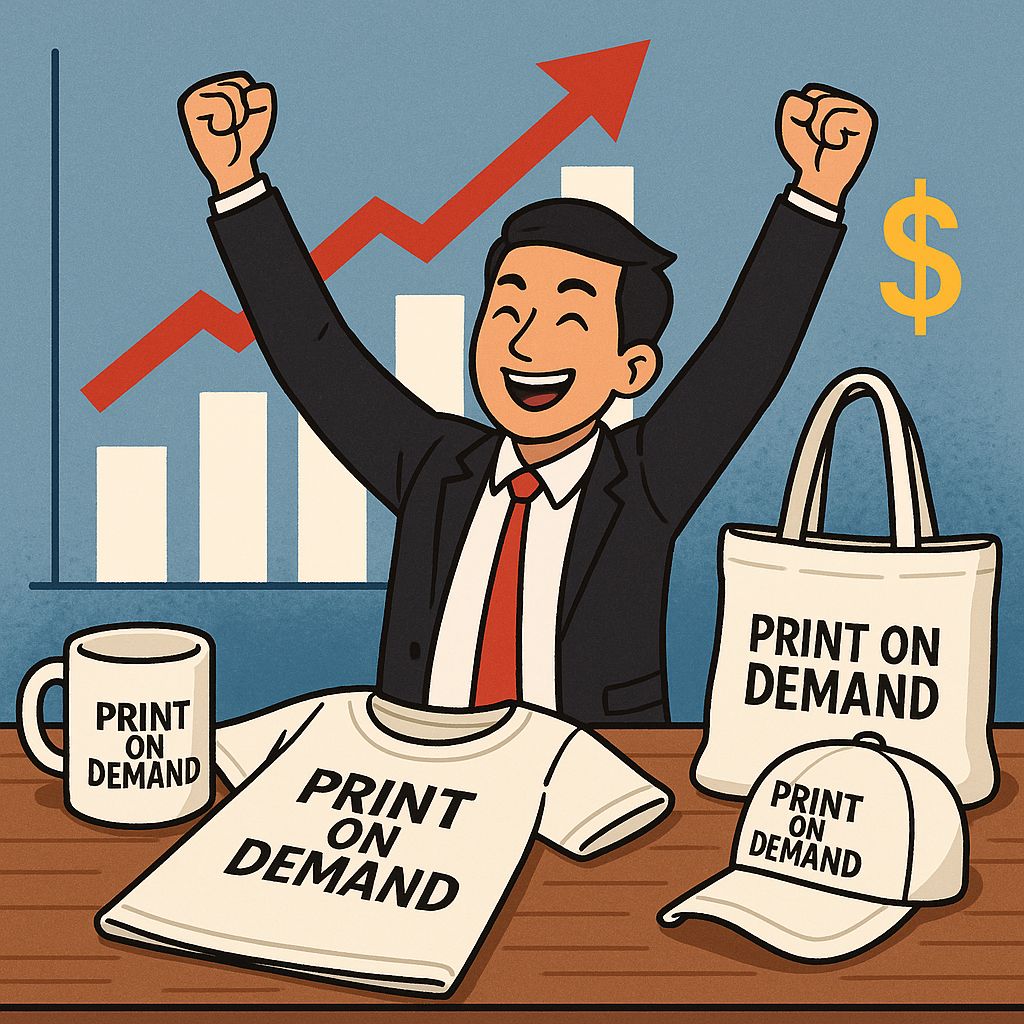
Remarkable POD Success Stories
The POD industry has produced numerous success stories that inspire and educate aspiring entrepreneurs:
Six-Figure Success: One Reddit user reported crossing $65,000 in POD sales in their first year, projecting $150,000 gross revenue by year two. Their success came from focusing on specific niches and investing heavily in quality designs.
Mom’s POD Empire: Emily built a $500,000 business while working full-time and raising children. Her strategy focused on simple, personalized gifts that solved specific customer problems.
The Design Investment: Another entrepreneur invested $15,000 in design fees during their first year, demonstrating the importance of quality artwork in POD success.
Key Success Factors
Niche Specialization: Successful sellers focus on specific audiences rather than broad markets
Quality Over Quantity: Investing in fewer, higher-quality designs outperforms mass production
Customer Service: Excellent support builds loyalty and repeat business
Consistent Marketing: Regular promotional activities maintain sales momentum
Data-Driven Decisions: Using analytics to optimize product offerings and pricing
Conclusion
Print-on-demand represents a revolutionary approach to creative monetization, offering unprecedented opportunities for entrepreneurs, artists, and businesses to generate income with minimal risk and maximum flexibility. The industry’s projected growth to $102.99 billion by 2034 demonstrates the massive potential for those willing to invest time and creativity into building successful POD businesses.
The key to POD success lies in understanding your target market, creating compelling designs that resonate with customers, and implementing effective marketing strategies that drive sustainable growth. With AI tools democratizing design creation and automation streamlining operations, the barriers to entry continue to lower while opportunities for innovation expand.
Whether you’re a seasoned entrepreneur or someone just starting their creative journey, print-on-demand offers a viable path to financial independence and creative fulfillment. The combination of low startup costs, global reach, and unlimited scalability makes POD an attractive option for anyone looking to monetize their creativity in the digital age.
As the market continues to evolve with new technologies, platforms, and consumer preferences, those who stay informed about trends, invest in quality, and maintain focus on customer satisfaction will be best positioned to capitalize on the tremendous opportunities that print-on-demand provides.
The future of creative monetization is here, and it’s printed on demand.
Ready to start your print-on-demand journey? Begin by researching your niche, selecting a platform, and creating your first designs. Remember, success in POD comes from consistent effort, quality products, and understanding your customers’ needs. The opportunity is vast – it’s time to make your mark in the growing world of print-on-demand.
